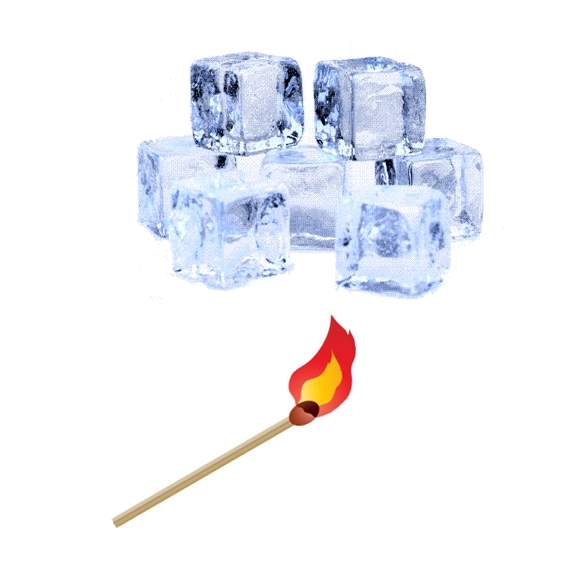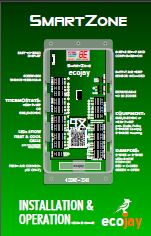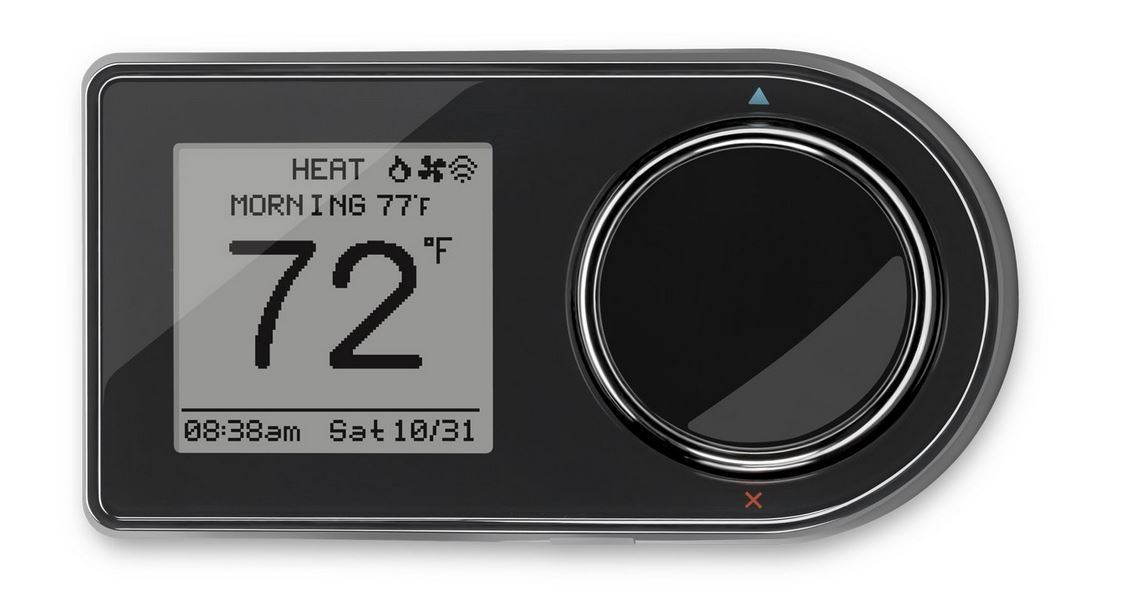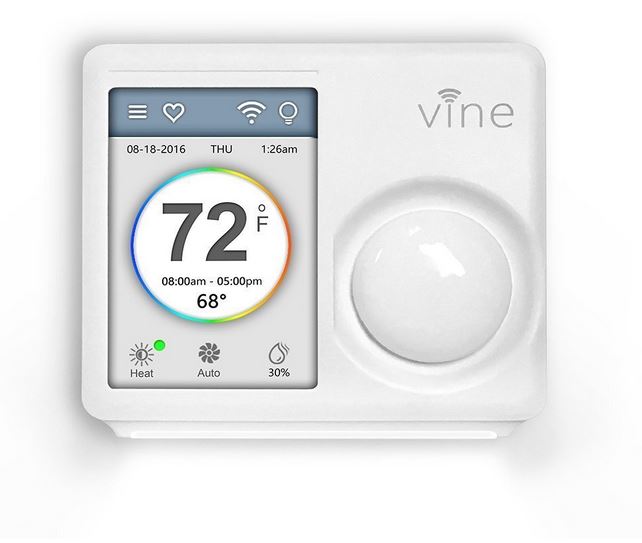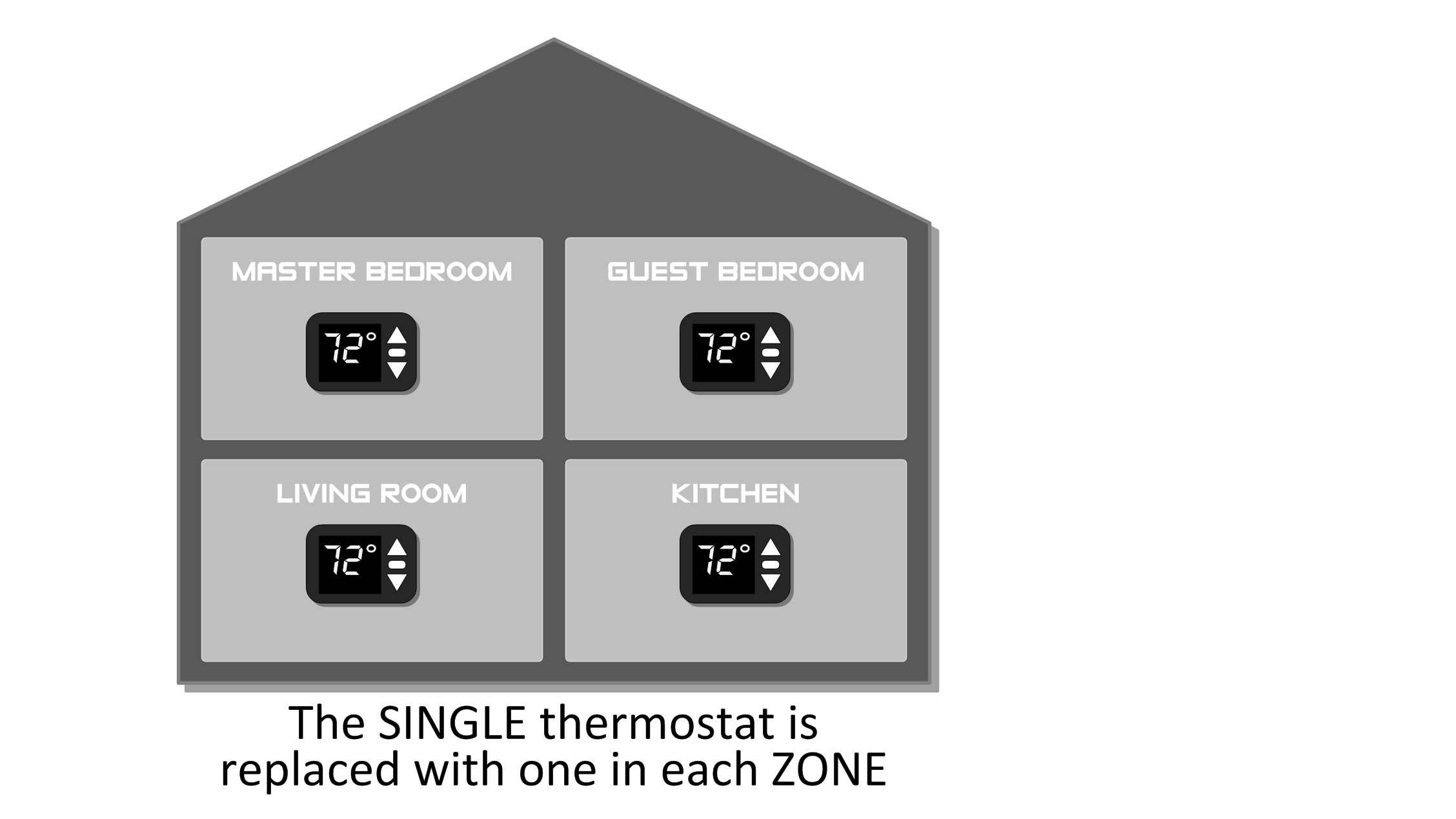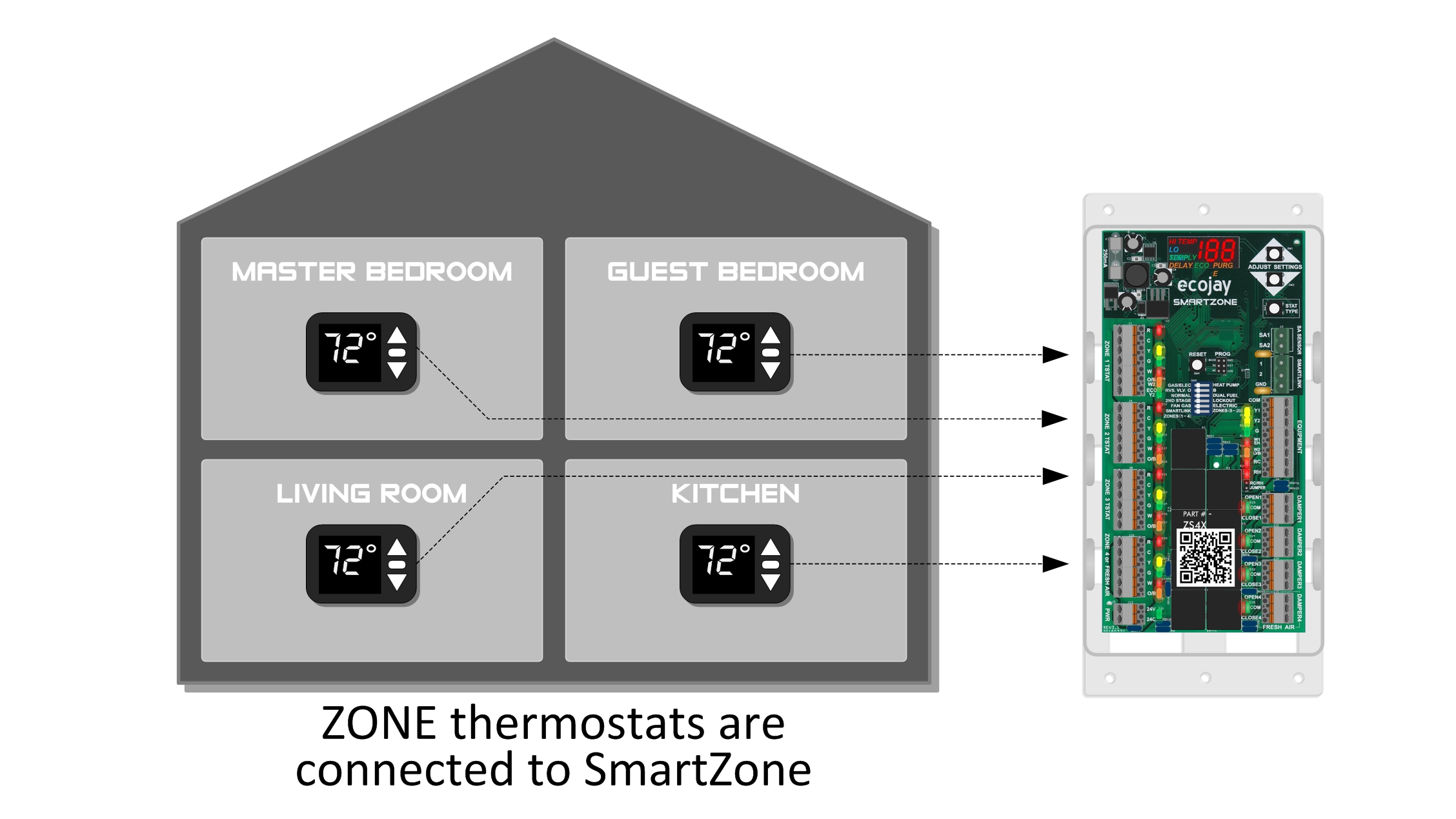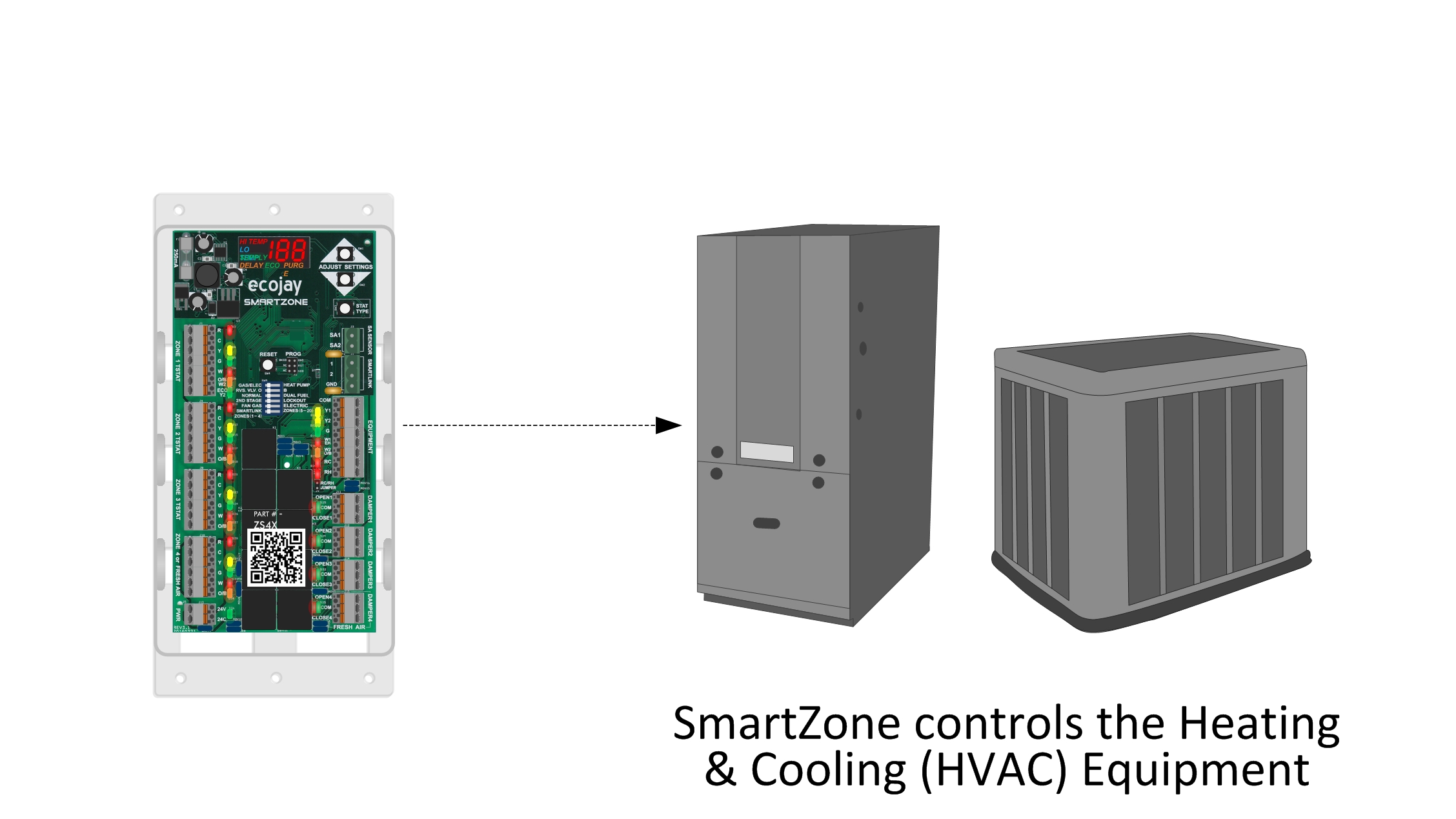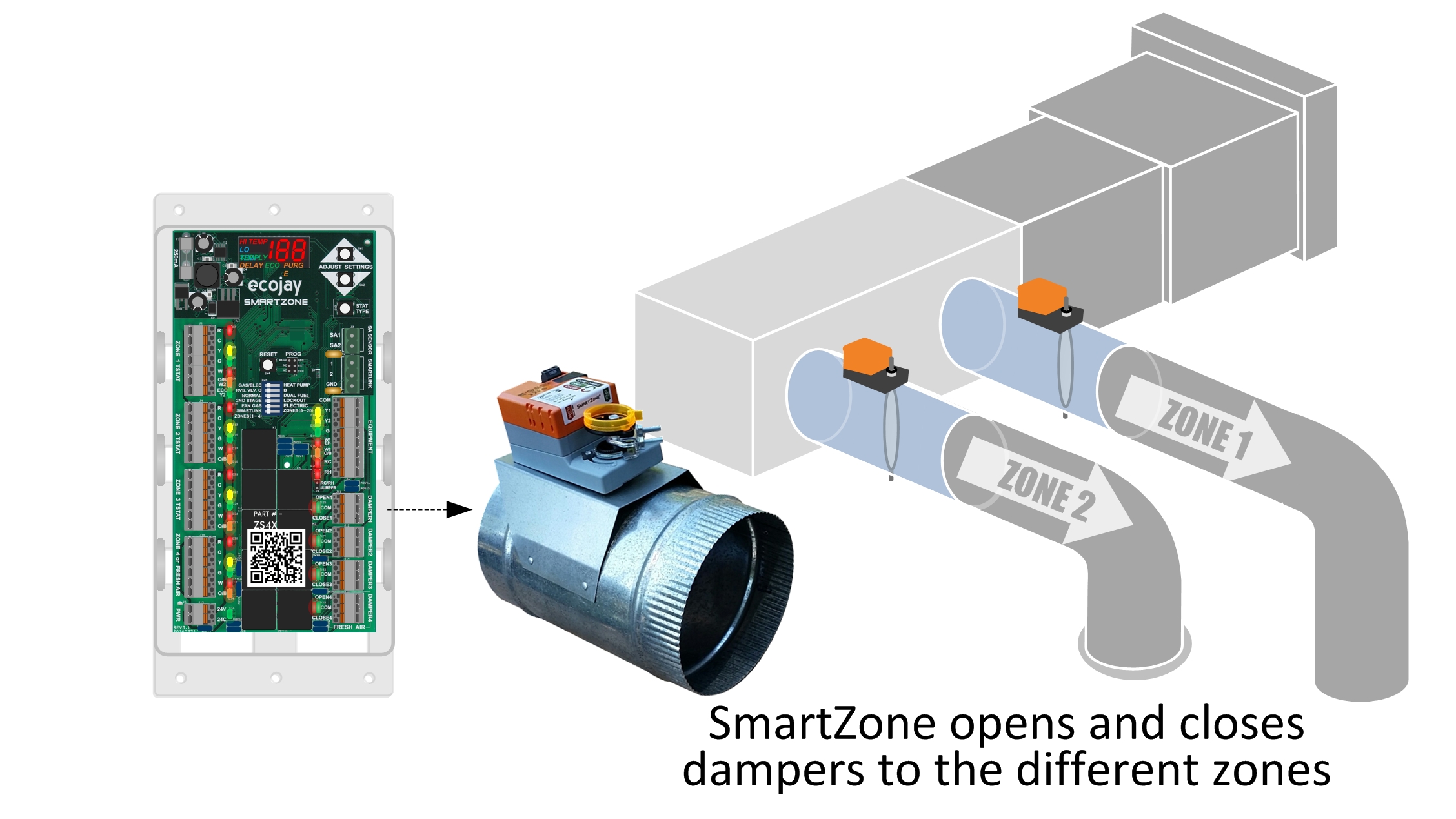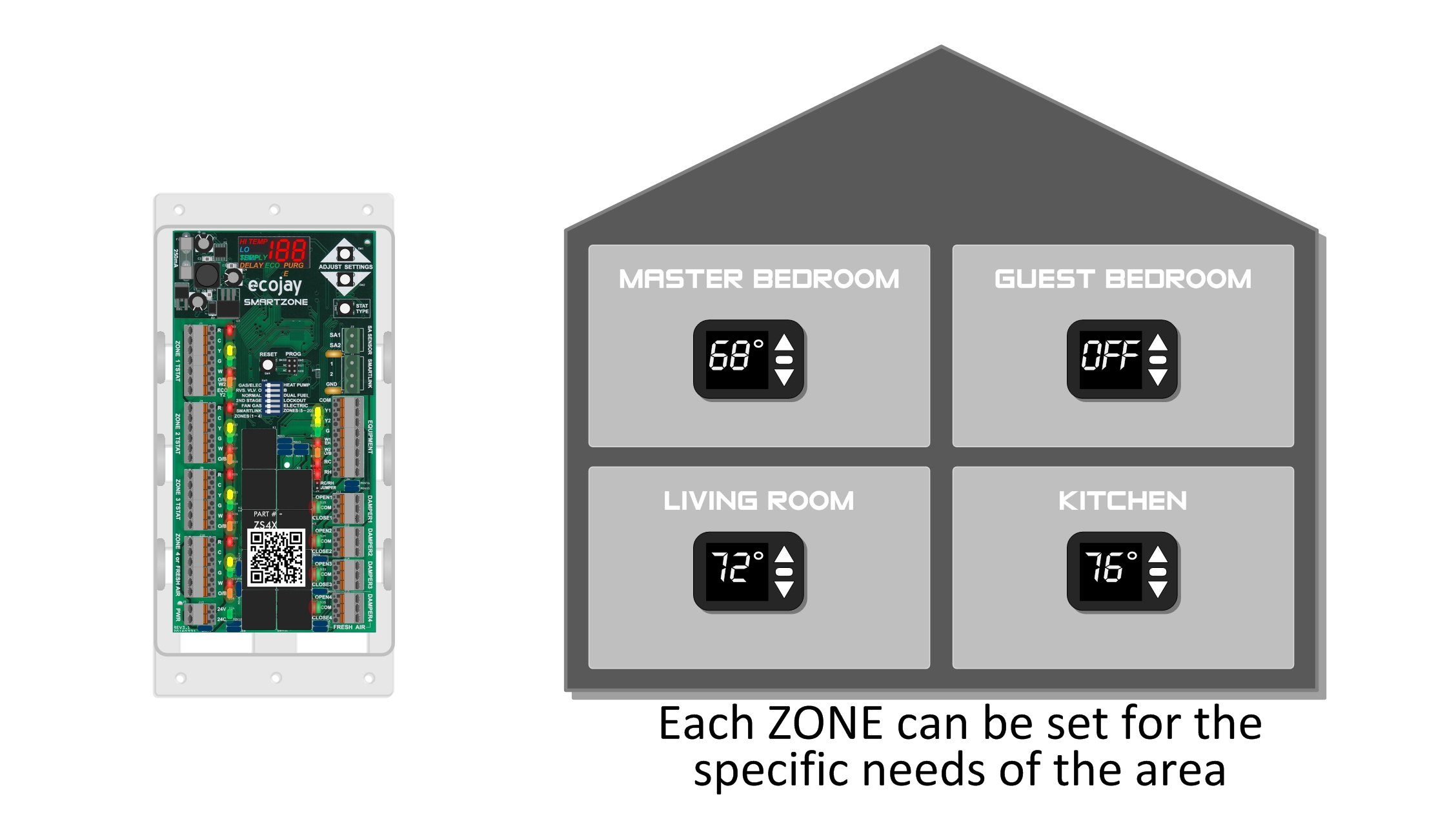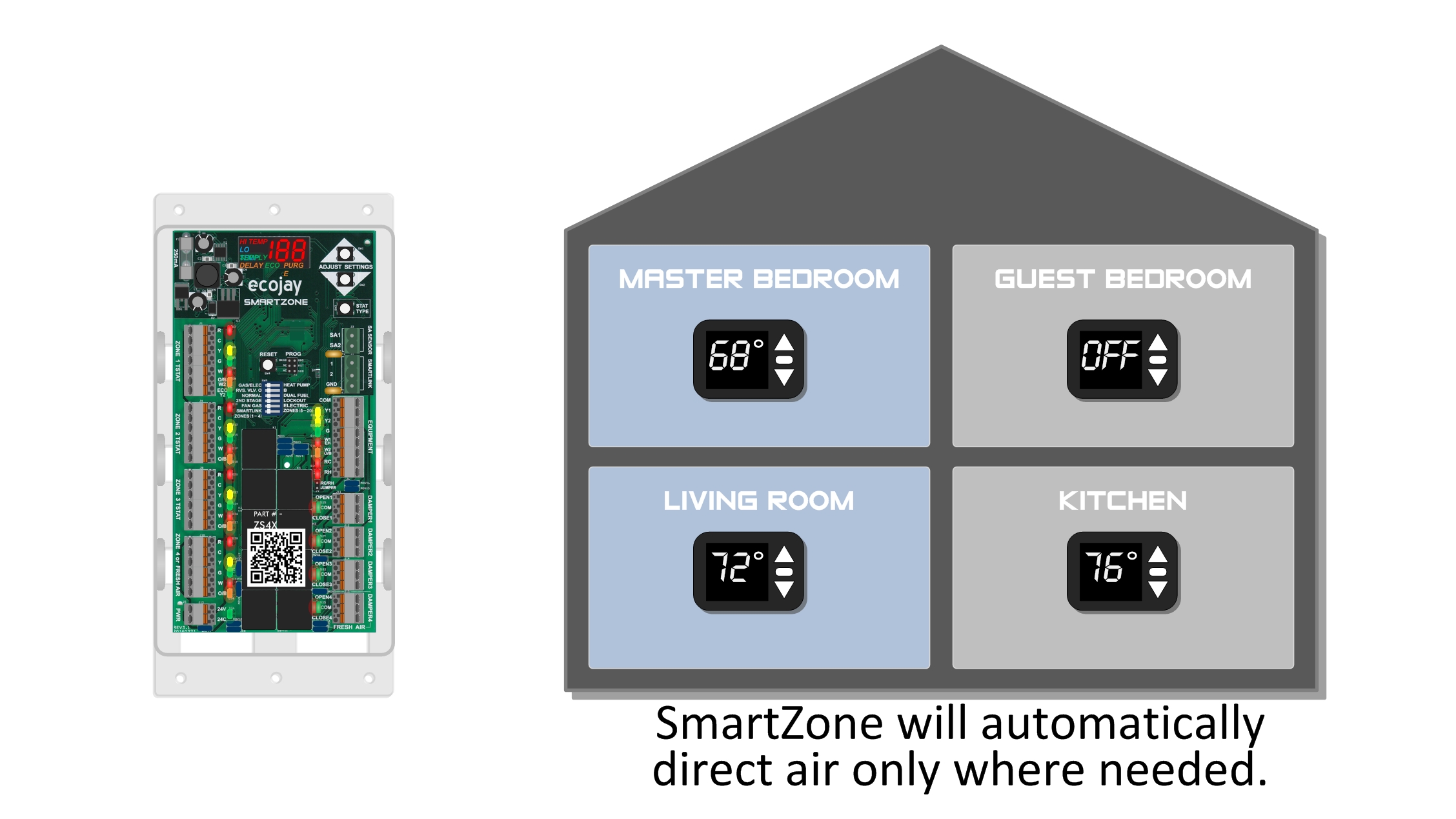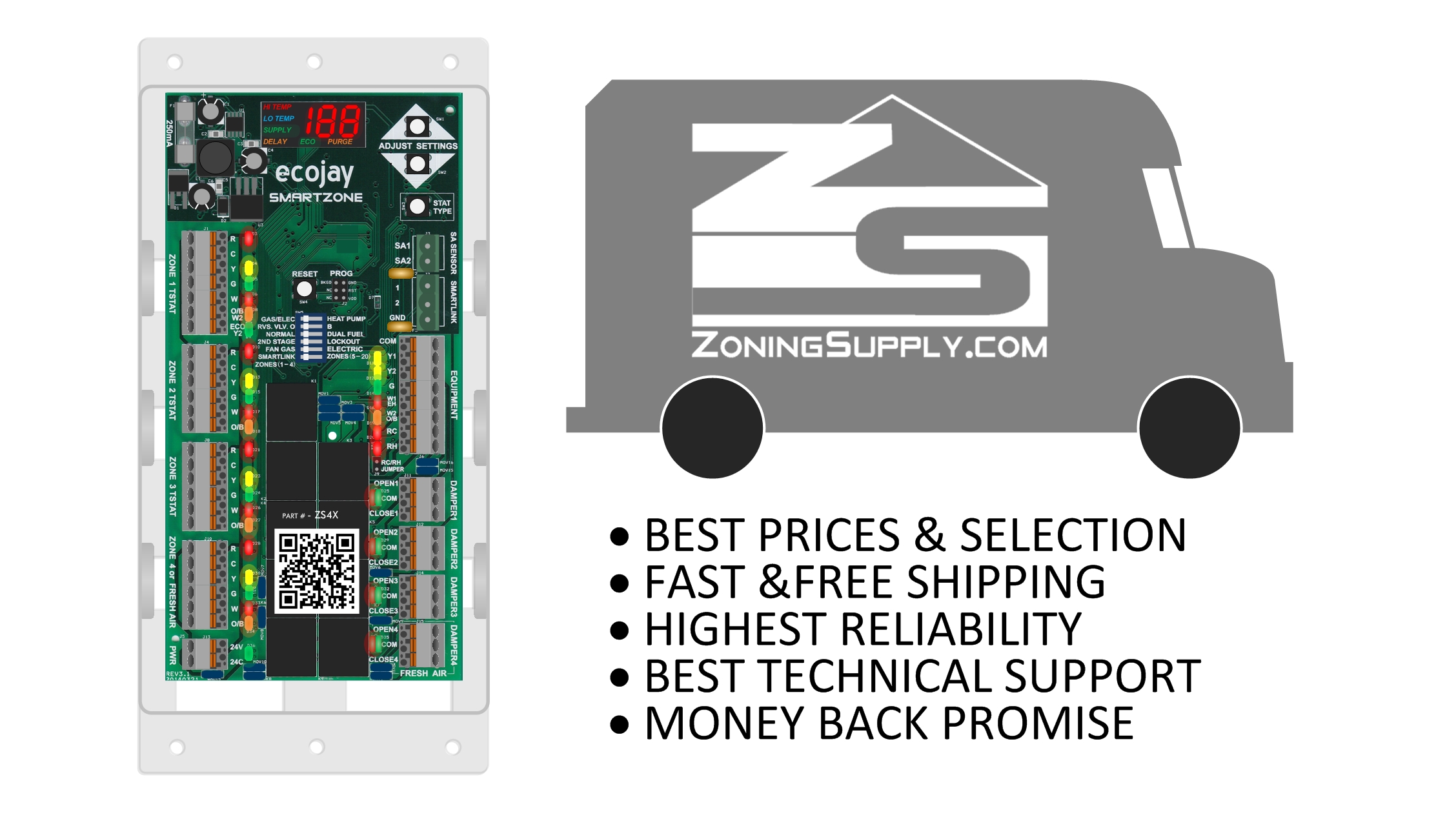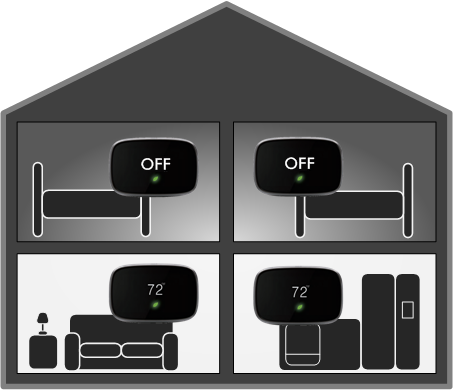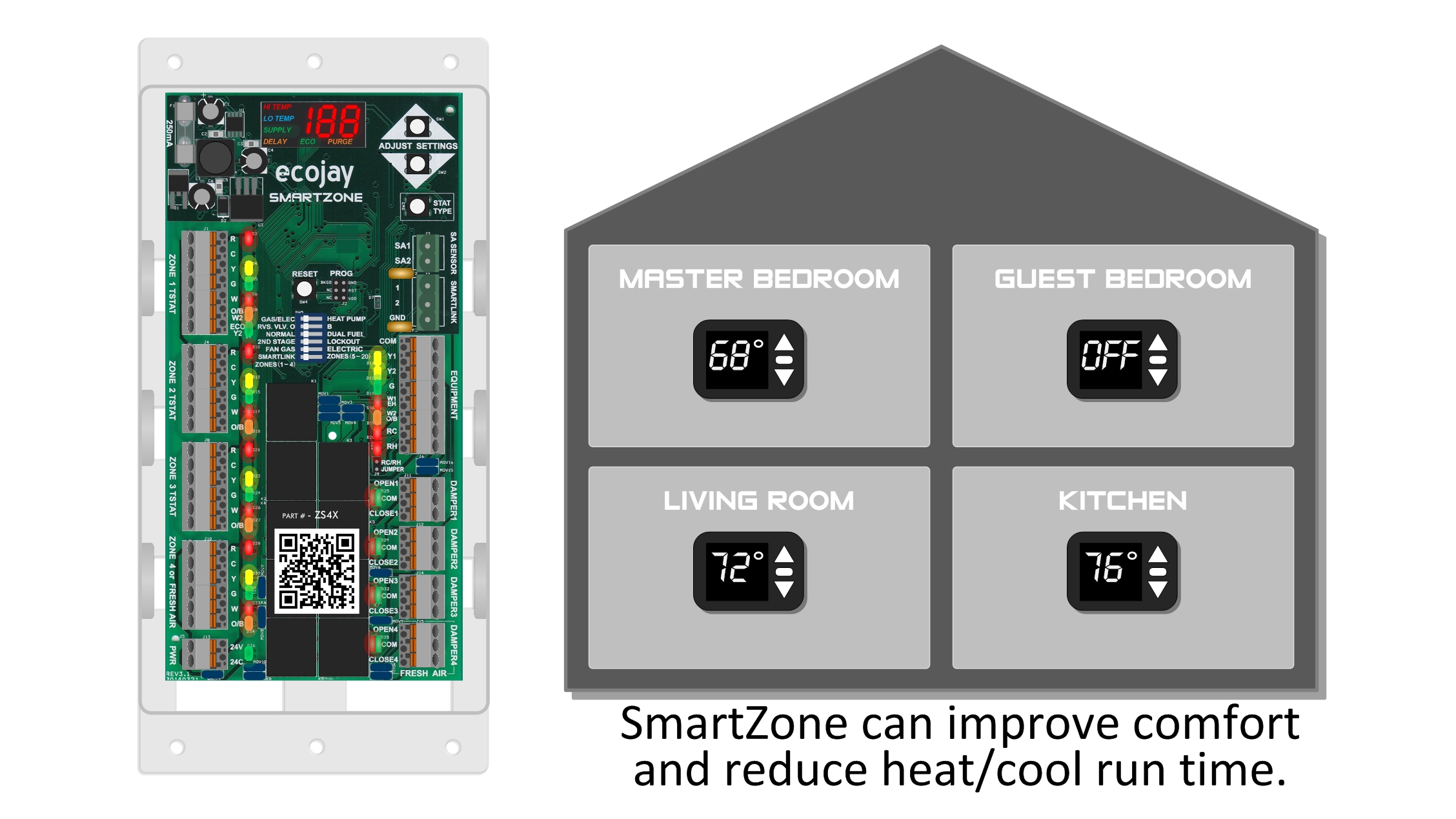During the cold days winter it's nice to get cozy by the fireplace or curl up under a warm blanket.. or in the summer you might find yourself standing in front of the air conditioner vents or a fan for a little relief from the heat. Is this because it's just not possible for your entire home to be comfortable? It may be because you are concerned with the energy use or $$ being spent to keep the home cool/warm OR it may be that certain areas of your home just never seem to be comfortable. If one or more rooms in your home seem to ALWAYS be outside your "comfort zone", Ecojay's SmartZone may be able to help. Directing airflow (heat/cool) to the rooms that you want, can make rooms in your home comfortable when you want them to be.
homeowners,Support
Home comfort hack: Could ZONE CONTROL improve your home's indoor climate?
homeowners, Zone Control InfoCommentInstalling zone control in your home allows you to add thermostats to several areas (rooms) so temperature can be controlled throughout the house. Most homes have only a single thermostat located in a "central" area. This means the temperature of the whole house is determined at this one spot. With zone control, temperature is measured and controlled in each zone for more comfort everywhere.
There are many reasons that zone control might be desirable (or even necessary).
- Homes with two stories where the upstairs is regularly warmer than downstairs during the winter can benefit from zone control.
- If a house has a fireplace that causes some areas of the home to get too cold when a fire is burning, zone control can help balance the temperature and keep those cold areas warm.
- Bonus rooms or unused bedrooms can be turned off with zone control when not in use.
- Computer rooms or grow areas that need to be a different (more consistent) temperature than the rest of the house.
Zone control can balance temperatures to create a comfortable living space throughout your home or create different temperatures throughout a building for varying needs.
CLICK HERE to find out more about how HVAC Zone Control works and if it will work for you.
What's a TON got to do with AC?
homeowners, Other HVAC2 CommentsSo you've probably heard of someone refer to an air conditioner's size in terms of "TONS". Something like "I got a new 4 TON HVAC unit". This refers, not to physical size, but to the capacity (ability) of the equipment to generate heat. That's right, even air conditioning (cooling), is sized by it's ability to produce heat. In the case of air conditioning, the heat is being "pulled" from inside the house and dispersed outside. This is why there is always an outdoor component (the air conditioning compressor) when you have AC.
Back to TONs... most people thing of a TON as being 2000 lbs. but with regard to HVAC, a TON is a measurement of heat generation per day.
1 TON of air conditioning is a measure equivalent to the amount of heat necessary to melt 2000 lbs of ice (H20) in a 24 hour period.
But how did we get there? A BTU (British Thermal Unit) is the unit we use express heat energy. One BTU is equivalent to the amount of heat energy released when burning 1 match all the way. When rating an HVAC unit either for heating or cooling, the amount of BTUs per Hour is often sited. It has been measured that it takes 143 BTUs to melt 1 lb of ice. Since, 1 TON of ice is 2000lbs, It will take 2000 x 143 = 286,000 BTUs to melt 1 TON of ice. The ice could be melted by lighting 286,000 matches all at once or by lighting one at a time... In other words, BTUs only tells us how much heat energy is necessary but not over what time period. It could melt in 1 minute, 1 hour, or even 1 year depending on how the energy is generated. So, to rate the output of HVAC equipment, someone decided back in the early 1900s (probably someone at Carrier) that it should be done over a 24 HR peroid (1 day). This is how we get 286,000 BTUs / 24 hrs =~ 11,917 BTUs per hour or commonly know as 12K BTU/hr is equal to 1 TON.
This means that that 4 TON AC unit you have can melt 8,000 lbs of ICE per day or about the same size block of ice as a Suburban. That's a lot of heat energy!
ADD-A-WIRE with Zone Control
HVAC Contractors, homeowners, Other HVACCommentAn ADD-A-WIRE device can be used when upgrading to thermostats that need a "COMMON" wire from one that didn't have one... and there is no way to run the additional wire needed. This device, ranging from $15 to $40 can come in very handy especially in the case of zone control where one or more thermostat does not have enough wires to accomodate a modern thermostat such as a WiFi thermostat.
Be sure to follow the wiring diagram for the specific model of "ADD-A-WIRE" as well as the system type. Show here is the LUX Products LPB-WH Power Bridge wired to a GAS/ELECTRIC thermostat and SmartZone-4X controller, however, the basic principal is the same for any application.
All of the different ADD-A-WIRE models come with instructions, read them carefully and follow exactly and you won't have any problems.
For more information about the method of ADD-A-WIRE when there is no way to run an extra wire from your zone panel to your equipment, check out this post:
https://zoningsupply.com/blog/upgrading-thermostats-solving-a-common-problem
From an engineering perspective this is an elegant and simple solution. Without giving away trade secrets, the ones i have tested use the a half wave bridge using diodes at the thermostat and some simple relay logic plus the another half wave at the equipment (no micro necessary) to use only 1 wire for both Y and G signals.... brilliant.
For more information, or with any questions, please contact us.
Upgrading thermostats; solving a "common" problem
HVAC Contractors, Support, homeowners1 CommentSo, maybe you have decided to upgrade to a Wifi thermostat, or even just a standard "programmable" thermostat... only, you come to discover that your old thermostat has one less wire connected to it than the new thermostat needs. This is usually the "24VAC Common" wire sometimes just called "C" or "24C". This means that your old thermostat was either mechanical, power stealing, or battery operated... which isn't a problem if you don't want a modern thermostat. MOST modern thermostats (especially WiFi) need a "C" wire from the 24V transformer to power the thermostat... this means getting a "C" wire to the thermostat.
This isn't a new problem, it started showing up in the 1980s with the first programmable thermostats... over the years, I have suggested and used several different methods to overcome this issue both with zoning and with typical single thermostat applications. Until recently, I couldn't really recommend anything other than running a new wire... and running a new wire isn't always possible.
METHODS to add "C" Wire
- Run another wire to the thermostat
The most straightforward and full-proof method is obvious: run another wire. If possible, this is ALWAYS your best solution. - Power thermostat from separate transformer
Don't use this method... it is risky and not all thermostats support the ability to separate the "R" from the equipment transformer. - Use the "G" wire for "C"
This method DOES work but it limits the functionality of your thermostat control. (ie. you will not be able to independently control fan from the thermostat) The reason this works, is that the equipment automatically turns the fan on during a heating or cooling call, so the "G" wire controlling the fan from the thermostat is only necessary to turn the fan on by itself. You will NOT be able to turn fan on from the thermostat by itself with this method.
NOTE: This works with MOST equipment, but you should check or test before employing this method. (#3) - ADD-A-WIRE Device
It is the BEST method and really the only method I would use if a wire cannot be run. This is a relatively new concept to me... it has been around for a few years at least but we just started recommending it within the last 2 years. Several companies have started offering an "ADD-A-WIRE" device that allows the addition of a "COMMON" wire. These devices range from $15 - $40 and are very simple to wire (you have to be able to get to your equipment furnace/blower).
How an ADD-A-WIRE Device works:
It will come in 2 pieces, one is a small box with several connections labled "R", "C", "Y", "G", "W". You will follow the included wiring instructions to connect this box at your indoor HVAC equipment. The other piece that comes with the ADD-A-WIRE is a wiring connector with 3 leads, this connects at the back of your thermostat as shown in the wiring instructions.
Once these two pieces are wired properly you will have the "C" you need for any thermostat... it's almost like magic (electrical engineering magic).
NOTE: Make sure all wiring is done with the power to the HVAC equipment OFF at the breaker.
A few different models to choose from (prices on amazon at time of writing) There are many others available but they all do the same thing (NOTE: we are not compensated by any of these companies or any others for our opinions):
- LUX Products LPB-WH - $18 (Our favorite because it's the easiest to wire)
- Venstar ACC0410 - $27
- Honeywell THP9045A1023 - $15
For more information about specific use with zoning and zone control systems such as SmartZone... contact us
Another thing to consider: The ecobee3 and ecobee3 LITE both come with an "ADD-A-WIRE" type device. So, if you are thinking about a WiFi thermostat and are afraid you will need to add a wire... keep the ecobee in mind. See our WiFi stat roundup for more info
De-humidification and SmartZone - Zone 1 Thermostat Control
HVAC Contractors, Other HVAC, Support1 CommentAlthough SmartZone does not have any built-in capabilities for controlling DE-humidification (DH) or Humidification, some applications are possible by using a thermostat on ZONE 1 that does have the capability to control DH.
“DE-humidification, in most residential systems, is simply running the equipment in COOLING with LOW speed fan instead of HI speed fan.”
Before we get to zoning, the equipment being used must have the capability to control humidity. This usually means it has a terminal (DH/BK/DS) that is energized or DE-energized by a thermostat to control fan speed of the equipment. Controlling fan speed allows the equipment to DE-humidify the air when the fan is running in low speed.
Back to zoning, using zone 1 thermostat to control DH is not as simple as wiring directly from the thermostat to the equipment. PLEASE DO NOT DO THIS. The equipment and the zone thermostats are running on different transformers and this will case problems and potentially damage to some components. You could isolate the output from the thermostat with a relay to get around this issue of different transformers but you would still have an issue with this method of wiring "around" the zone controller. The issue can arise when zone 1 calls for DH but the equipment is already running in heat, this mixed signal might just be ignored by the equipment but we cannot take that for granted... all equipment works differently.
The best way to control DH using SmartZone on single stage equipment is by using the method below. It may seem a little UN-orthidoxed but it is a valid APP note from the engineer at Ecojay (It's intended to work this way).
- Select a DH enabled thermostat of your choice
- Connect Y2/ECO on SmartZone Zone 1 to Zone 1 Thermostat DH/DS/BK
- Connect Y2 on SmartZone Equipment toEquipment DH/DS/BK
- Set Zone 1 "STAT TYPE" to G2
- Set DIP switch #4 to "LOCKOUT"
Zone 1 thermostat will now enable and disable DE-humidification any time the equipment is running in the cooling mode.
NOTE: When starting cooling from OFF state, 90 second delay will occur before HIGH speed fan will energize.
Using this method we are assuming that the equipment is expecting DS/BK/DH input terminal to be ENERGIZED for high speed fan and DE-ENERGIZED for low speed fan. This method should not be used for more than 3 zones or with multi-stage compressor equipment.
This application will work with Ecojay's SmartZone-2X and SmartZone-4X. Learn more
WiFi Thermostat Roundup 2017
homeowners, Other HVAC, thermostatsCommentJust a few short years ago, WiFi thermostats were only made by a very few companies starting with Ecobee and RadioThermostat, followed by Nest. A couple of years pass and big names in the HVAC industry (Honeywell, Emerson, Venstar, etc) join the WiFi thermostat party. In 2017 we have more to chose from than can easily be kept up with. Note: All prices as of this article publish date.
All of the WiFi thermostats listed below will work with any SmartZone
I am sure there will be even more on the market in 2018, we will keep watching the WiFi thermostat bubble grow! More than 15 are listed here (and I know they are not all listed). If you know of any more, comment or tweet to us @zoning_supply
Bosch - $ 170, 4-Heat, 2-Cool, GE/HP, Hum, deHum, Color: White
https://www.amazon.com/dp/B073XHD8BB
Ecobee Si - $ 145, 2-Heat, 2-Cool, Color: White
https://www.amazon.com/ecobee-Thermostat-Heat-2-NON-Touch-Screen/dp/B008F40R4C/
TOP PICK
*Ecobee 3 - $ 169, 3-Heat, 2-Cool, Best for zoning in our opinion.
https://www.amazon.com/ecobee3-Smart-Thermostat-Works-Amazon/dp/B06W56TBLN/
PREMIUM CHOICE
Ecobee 4 - $ 247, 3-Heat, 2-Cool, Alexa-Enabled
https://www.amazon.com/ecobee4-Alexa-Enabled-Thermostat-Sensor-Amazon/dp/B06W2LQY6L/
Emerson Sensi Color Touch - $ 169, 2 Heat, 2 Cool, GE/HP
https://www.amazon.com/dp/B01N3CEUDH?psc=1
Emerson Sensi - $ 99, 1 Heat, 1 Cool, GE/HP
https://www.amazon.com/dp/B00HHE6CW2?psc=1
Nest - $ 249, 3-Heat, 2-Cool
https://www.amazon.com/dp/B0131RG6VK/
Honeywell Color Touch - $ 190
https://www.amazon.com/Honeywell-TH9320WF5003-Touchscreen-Thermostat-Amazon/dp/B00G4CIG7M/
Honeywell Lyric T5 - $ 110
https://www.amazon.com/Honeywell-RCHT8610WF2006-Programmable-Touchscreen-Thermostat/dp/B01LTHM8LG/
Honeywell Lyric Round - $ 170, Geofencing
https://www.amazon.com/Honeywell-Thermostat-Contractor-Version-Amazon/dp/B00KX3M1LA/
Honeywell Basic 7-day - $ 90, 1-Heat, 1-Cool, GE, Color: White (Yes this is WiFi--even though it doesn't look like anything other than an inexpensive thermostat)
https://www.amazon.com/dp/B00Y6M2OUC/
Honeywell B&W Touch - $ 118
https://www.amazon.com/Honeywell-Wi-Fi-Programmable-Touchscreen-Thermostat/dp/B00EP6C8UA/
iDevices Thermostat - $ 112
https://www.amazon.com/iDevices-Thermostat-Wi-Fi-Works-Amazon/dp/B019GQM6LY/
VALUE CHOICE #1
Lux PRO GEO - $ 115, Geofencing, Mount Vertical or Horizontal, Color: Black or White
https://www.amazon.com/Lux-Products-GEO-WH-Thermostat-Amazon/dp/B010PTKWW6/
RadioThermostat - $ 99, 2-Heat, 2-Cool, GE/HP, Modules for Zigbee & Z-Wave
https://www.amazon.com/Radio-Thermostat-Programmable-Enabled-Controls/dp/B00KQS35XA/
VALUE CHOICE #2
*Vine - $ 99, Settings Knob, Color Screen & Night-Light
https://www.amazon.com/Vine-Programmable-Thermostat-Touchscreen-Nightlight/dp/B01JU1DZN8/
Vine Touch - $ 129 Color Touch Screen,
https://www.amazon.com/Vine-Smart-Wi-Fi-Thermostat-TJ-919/dp/B01N7UNSAP/
Any information in this article should be verified with the manufacturer of each product listed. Specifications, prices & availability are all subject to change and will not be kept current on this post. Please email us if you have any questions.
ALSO NOTE: We (I) have not been paid or compensated in any way for this article by any of the manufacturers of these products. I have not even received any free product... anything reviewed has been purchased through retail outlets and tested with SmartZone zone control products for the use of ZoningSupply.com customers. This information is not intended to be exhaustive or claim expert knowledge about all of these thermostats. Thank you.
Need more than 40VA to power LOTs of dampers on one SmartZone?
HVAC Contractors, SupportCommentSome systems with many small ducts leading to each zone can require lots of dampers. The example below is a 2 zone system that requires 6 dampers per zone (12 total). If you look at the zoning guide, you will find that you should budget for at least 55VA for this system... but you only have 40 VA transformers. 75 and 100 VA transformers can get VERY expensive! Instead you can use two 40VA transformers, but not how you think. It can be dangerous and unreliable to connect transformers in parallel to create ~80VA. We recommend the method below that employs the use of a simple relay to separate half of the dampers to be powered from a second transformer and the other half being powered by the SmartZone and it's transformer.
See the SmartZone Install Guide to calculate required VA.
It is always necessary to verify that the PRIMARY side power is sufficient to power the transformer connected. A dedicated PRIMARY circuit is best but not always possible. If sharing the 110V or 220V circuit, make sure the total power required for all devices connected (including zoning transformers) doesn't exceed the capacity of the circuit (usually 15 or 20 AMPS).
Where to get a relay?
Any 24V relay with a DPST or DPDT configuration will work. The one pictured in the above diagram is available at ZoningSupply.com (see below). If you are chosing your own relay, the "Contact" current rating will determine how many dampers can be connected. (For example: A 10 Amp relay can handle up to 10 power open, power closed dampers)
Ashrae 62-2 Ventilation (Fresh Air) sizing & calculation
HVAC Contractors, Support, Other HVACCommentMany homes these days have such tight seals around doors, windows, and even closed-cell foam insulation... they are almost air-tight. You can think of an old house like an antique metal or wooden ice box where modern homes are more like Yeti coolers. While this is great for keeping temperatures steady inside the home, it also can trap moisture and toxic gases inside. Fresh air ventilation is necessary to keep a healthy and efficient home.
But how much fresh air is needed? If you bring in too much, you will make your HVAC equipment work too hard and loose efficiency. If not enough fresh air is brought into the home, the air can become humid and allow mold growth or VOCs and other toxins can build up. Luckily, the national organization ASHRAE has a specific recommendation for the amount of air based on occupancy and square footage of the home. See table below.
Taken from SmartZone-4X Install Guide
However, this table should not be taken as gospel. Just like other HVAC calculations and estimations, many factors are not really being taken into account with this rough estimate based on # of bedrooms (occupancy) and square footage. Some adjustments may be needed based on factors such as climate, ceiling height, other air-leakage, etc. To comply with 62-2 is the baseline & adjustments can be made in the field by setting run-time.
Learn more about how SmartZone-4X can control fresh air more efficiently than a separate fresh-air controller in the Install Guide
Zoning for comfort and / or economy... basics of HVAC Zoning
homeownersCommentWe have explained in other posts on ZoningSupply.com, when it comes to HVAC zoning, each application must be evaluated individually. Situations vary widely from building to building, but, in all cases HVAC Zone Control puts the user (homeowner, building manager, etc) in control of comfort.
Let's rewind, what is zoning? Homes and buildings that have "central" heating and air conditioning typically have 1 thermostat that controls the whole house temperature. With zoning, multiple thermostats can be placed throughout the house to better control temperature throughout. SmartZone connects to all of the thermostats & automatically controls dampers (air valves) installed in the air ducts. These air ducts direct air from the heating & cooling equipment to the different areas or "zones" of the home/building. The dampers allow SmartZone to direct air only where needed.
Once a SmartZone has been installed, you will have the ability to set each of the zone thermostats to whatever temperature or settings you desire. SmartZone will, within reason, keep each zone at the correct temperature by running the equipment and directing hot or cold air into the zones only when necessary. This achieves the purpose of comfort control to manage hot or cold areas of your home.
As for energy savings, if some of the zones are rarely used and can stay off for a sufficient amount of time, the equipment will run for a shorter time to heat or cool the rest of the building. This and other applications that allow the user to turn off or set-back one or more of the zones can, in some cases, result in energy savings. Some sources have published % energy savings possible with zoning, however, this is too arbitrary to have any real meaning. Like stated at the beginning, every application is different & the real possibility of energy savings is in the hands of the user and how the thermostats are set.
Zoning is an amazing solution to comfort issues and gives the user ultimate control over comfort throughout the home or building. However, zone control is NOT a magic bullet for energy savings. HVAC Zoning only puts more control in the hands of the user & it is ultimately the thermostats and how they are set that determines potential energy savings.
Use Wifi thermostats with SmartZone for ultimate control over comfort and energy use.
The reality is that in a normal home with one thermostat, the only way to get more "comfort" is to spend more energy (ie run the AC or heat). With zoning, you can stay more comfortable in some areas while reducing run-time by not heating/cooling other areas.
SmartZone is the best hvac zone control for upgrades or new-installs. Order today and install yourself of call any HVAC contractor in your area for installation.
Fact or Myth? #HVAC #Zonecontrol can save energy
homeowners, HVAC ContractorsCommentFirst of all, if you are not familiar with HVAC Zoning (Zone control) for your home you can click here and learn more about how it works.
Sometimes, zoning is pitched as a device that can be added to your current HVAC system that will "save you energy" because you are able to turn "off" heating and cooling to areas that are not being used. Sounds good, right? Well...there a "but." This as actually a highly debated or more aptly put... highly contested claim among HVAC professionals.
The simple fact is that it isn't a simple answer but the simplest version is: HVAC Zoning CAN save energy in some applications.
Not all applications of zoning are intended to save energy, some are set up to optimize comfort. In these situations, energy savings may not the top priority but it can still be set up to help save energy when the comfort is not in demand.
Zoning puts the control in the hands of the user (homeowner) via the thermostats. These thermostats can be set to optimize energy savings or comfort... or, most likely, somewhere in between.
Some believe the primary purpose of zoning is comfort & I would agree, but, SmartZone can be used in some applications to save energy by reducing necessary run-time.
As far as I have found there have been very few and NO independent studies on the energy savings capabilities of hvac zone control but I have personally been in the industry for 14 years and I believe I know why. Every test I have seen is try to prove some % of energy savings and yet there is a flaw with even the question that is being asked. The problem with this question is that it is looking for an automatic percentage saving when zoning is installed. I think this gets to the heart of why the professionals that dispute zone control's ability to "save energy" do so.
This is an IMPORTANT NOTE: HVAC Zone Control by itself will NOT save energy. However, it CAN be used to save energy.
A proper study to prove that zone control CAN save energy would be straight-forward. Two identical houses with identical hvac systems, one with a 2 zone system & the other with a single thermostat. On the house with zoning, set one thermostat to OFF 12 hours per day and the other thermostat to run a normal 24hr / 7 day schedule. The thermostat schedule should be the same as the 24hr / 7 day schedule in the house with only one thermostat. This study would show that zoning can save energy if used in certain ways.
SmartZone has been around since 2004 and we have over 200,000 installed in the field. We have seen direct feedback that empirically shows energy savings, not just in isolated cases but in extremely high volume. First hand, real-world experience shows that it can be done, but it also shows that in cases where comfort is the priority... energy savings isn't a guarantee with zone control.
Check out SmartZone at ZoningSupply.com
Spring is HVAC maintenance season... think about Zone Control.
homeowners1 CommentWith warmer weather approaching, upstairs or certain areas of your home can become uncomfortably warm without SmartZone. HVAC zone control can make the entire home more comfortable in the hottest Summer months.
Most homes with a single thermostat have some issues with keeping everyone, everywhere in the house comfortable. With SmartZone, thermostats are places throughout the home to achieve comfort everywhere... and if you choose to turn off some of the areas (zones), you can even save energy. Most importantly, however, SmartZone can make your home more comfortable than it is now. See the slides below for how it works.
How it works...
- SmartZone is connected to several Thermostats placed in "zones" throughout the home or building.
- SmartZone is connected to the Air Conditioning (AC) and Heating equipment.
- Dampers (air valves) are installed in the existing ducts that connect to room vents in the "zones."
- SmartZone controls the AC & Heating equipment AND opens/closes dampers to control air to the zones based on the thermostats.
There is obviously a lot more to HVAC Zone control than the above bullet points. Bypass & static pressure, duct sizing & damper leakage, thermostat & equipment types, equipment modes & changeover, compressor staging, emergency & auxiliary heat... and much more. The good news is that SmartZone takes the guess work out of the potential complications of zoning. Check out more about why SmartZone is the best choice here.
Hot upstairs "bonus" room? Cold downstairs during the winter?
homeownersCommentThese and many other common problems can occur during the winter months when the heater is running more than normal. This can especially happen in areas that have cooling systems to handle warm and hot summer months. The duct is often designed to be optimized in the summer months and when heat season rolls around, the airflow balance is all wrong. The solution is Zone Control. Even in the best designed duct systems, dampers are often used to balance the airflow on site. This is tedious and inexact... but with SmartZone controls and power dampers, your home can be comfortable everywhere year round.
"I have personally been in too many to count homes with two stories that NEED zoning... there is nothing wrong with the equipment capacity or the ductwork, they just need the ability to direct airflow in the areas that need it in different seasons of the year or even times of day" -- SmartZone Contractor
SmartZone is great for fireplace season... no more cold areas.
homeowners, Other HVACCommentMost people enjoy a good crackling fireplace when it's cold and snowy during the winter months even it isn't the primary source of heat for our homes these days... at least for most of us. One problem that is common with homes that only have a single thermostat (no zoning) is that when a fire is burning, areas away from the fire get colder than the rest of the house. Zone control can be the perfect solution...
2016 USER QUESTIONS - SmartZone Advanced
Support, homeownersCommentQUESTION: I have two 9580 thermostats one in the office, the other in the main hangar bay (two zones). When heating both zones or only the hangar, I need the furnace to go full blower with normal scheduling through stages 1 and 2. When servicing only the small office area, I don't want the system to advance from stage 1. Unfortunately, the office is so small and the modulating schedule of the furnace is still too much airflow for the office (the zone bypass when servicing the office is the main hangar modulating damper that is controlled via SPC (excess dumps into hangar)). This damper will be wide open during call for hangar heat. The main damper control logic is managed through a 3PDT 24 Vac relay. So, I need to block out stage 2 from only 1 zone (office). The zone ramping schedule of the 9580 works well with the 100k modulating furnace control board, and would like to keep that capability.
ANSWER: Configure the zone 1 thermostat connector STAT TYPE to G2 (conventional gas/electric) or H2 (heat pump) to allow the thermostat to control staging and use the hangar thermostat on zone 1. Wire only the stage 1 circuits (Y1 and W1) on the office thermostat to the zone 2 thermostat connector (Also connect R, C and G wires). Set dipswitch 4 to the LOCKOUT position. This will configure the zone controller to allow 2nd stage only when the hangar thermostat calls for 2nd stage regardless of whether the office thermostat is calling. When the office thermostat is calling and the hangar thermostat is not, SmartZone will not allow 2nd stage to operate.
“I called last week to inquire about using this zone controller in a hangar that had a small office area and a large bay. I advised the call taker that I had Honeywell 9580. I also asked about the capability of the zone controller to handle the smaller office area’s lower CFM requirement and whether or not I could defeat the step-up from W1/Y1 to W2/Y2. I was told that the controller can be set up to defeat the stage step-ups.
After reading the manual, I found that there are no multi-stage inputs on the controller board from thermostats. So, basically, the capabilities of the Honeywell 9580 are wasted. Also, the stage defeat is for the whole system, not zone-specific as I need. It would be pointless to defeat stage increases while heating/cooling a large hangar space”
ANSWER: The SmartZone controller typically controls staging based on the total system conditions which is the most efficient way to operate a multi-zoned multi-staged hvac system. However, the zone1 thermostat connector on SmartZone can be configured to allow the thermostat to control staging (refer to the top of page 10 of the installation manual). When the zone1 thermostat is configured for staging the ability to lockout 2nd stage with only 1 zone calling is disabled. With the thermostat controlling staging your ability to limit staging will be determined by the features of your Honeywell 9580 instead of the SmartZone control.
“I have a honeywell mastertrol2 mm2, i wanted to update my thermostats but my zone controller has separate b and o wires going to thermostats . Will updating my zone controller to a smart zone 2 help this problem?”
ANSWER: Updating your zone controller to a SmartZone 2 zone controller will allow you to use any 24VAC thermostat. SmartZone controls are designed to be universally compatible with 24VAC thermostats including WI-FI models used to control your thermostat remotely through the internet on your smart phone or tablet. You should be able to connect any 24VAC thermostat to a SmartZone control without any problems.
“Do you have a digital thermostat that you recommend or sell to go with SmartZone?”
From ecobee.com
ANSWER: ZoningSupply does not carry thermostats, however, SmartZone controllers are compatible with any 24VAC powered 5 or 6 wire thermostat. Popular brands our customers install with SmartZone include Honeywell, ICM, Braeburn, Nest, Ecobee, Aprilaire, Lux, Lyric, and MANY others. We suggest you avoid using low priced 'power stealing' thermostats as they may cause intermittent issues if your utility power fluctuates. Power stealing thermostats are typically low priced and can be identified by the lack of a C (common) terminal on the thermostat wall mounting plate.
If you are looking for a WiFi thermostat check out this other article:
http://zoningsupply.com/blog/best-wifi-thermostat-for-zoning
2016: QUESTIONS from ONLINE CUSTOMERS
Support, homeownersCommentQUESTION: Will SmartZone replace Honeywell Trol-a-temp?
ANSWER: The SmartZone-4X is a "drop-in" replacement for all of the Honeywell boards.
QUESTION: I live in Toronto, Ontario, Canada. Are there any qualified installers for the Smart Zone dampers?
ANSWER: Although we have customers in other parts of Canada, we do not have any specific HVAC contractor customers in Toronto. Any reputable HVAC contractor with previous experience installing zoning should be able to install the Ecojay SmartZone controls or dampers. Many do-it-yourself folks have also successfully installed Ecojay's controls/dampers without difficulty. If your contractor is not specifically familiar with SmartZone controls they can reach our technical support line, 844-ZONE-123, for assistance if needed. Feel free to contact us with additional questions.
QUESTION: I have an old DuroZone system (model SMZ-SW) that has stopped working and am looking for a replacement solution and have been researching the Smartzone option. I have a few questions and wanted to see if you could help me.
- I'm not sure what has failed with the DuroZone system, but I wanted to first see if I replaced the controller with the Smartzone controller if it would work. Will the Smartzone controller work with the DuroZone dampers ?
- Would you be able to put me in touch with an installer who could do the installation and testing of the smartzone controller ? I'm not overly handy and would prefer a knowledgeable installer to do the install and tests.
ANSWER:
- Ecojay's SmartZone products are compatible with your current DuroZone controller. Your existing thermostats and dampers are normally compatible with SmartZone.as well. Wiring the dampers into SmartZone may be different depending on the model dampers you have. We can provide damper wiring instructions when you or your installer inform us the damper models you have.
- The change out of your existing Durozone controller should be simple for any competent hvac contractor even if they haven't used Smartzone before. Zoning Supply can also be contacted for technical support toll free if you or the installer need technical assistance.
QUESTION: I have a Honeywell Chronotherm 111 system with one main panel and three mercury thermostat controllers. I have been informed that my control panel is inoperative and three dampers have failed. I would like to upgrade the system with out
losing the capability/control of the temperature in each room. I am in dire need to correct/improve my system with the Honeywell product.
ANSWER: The Honeywell Chronotherm III thermostat (models T8600, T8601 & T8603) are 24VAC powered according to Honeywell's spec sheet and should be compatible with any Ecojay SmartZone controller.
QUESTION: My customer has a Carrier/Parker zone system, not sure what version. I want to replace the complete system minus the dampers. Currently there is a main controller, bypass controller and six zones. The bypass could be converted to a dump zone. Wireless is also an option. What do you think?
ANSWER: From our knowledge of the Carrier-Parker controls, it is VVT control system and Carrier released two generations of the product line that we know of. One or both generations used dampers that had DC powered, multi-position actuators. Carrier has also tended to use a more proprietary control flow using a pulsed or multi-position damper actuator which do not have an internal stop switch. SmartZone outputs 24VAC continuously on either the OPEN damper circuit or CLOSE damper circuit with the actuator using an internal stop switch to switch off power when it reaches stop in either open or close position. This is typical of most conventional residential/light commercial zone control brands and product-lines today. If your customer's current system does not match this specification you will need to change out the damper actuators if installing Ecojay SmartZone or any other major 24VAC brand control product. Ecojay's damper actuators have a torque rating of 18 in-lb/2 Nm and can work with a round or square shaft of 1/4" to 5/8" diameter.
SmartZone is expandable up to 20 zones, capable of 2C/3H stages and is compatible with any conventional 24VAC controlled equipment including heat pump or heat pump with dual fuel. SmartZone is also compatible with all off the shelf 24VAC thermostats. If you are able to supply the specific product model your customer is using I can probably be more specific about the compatibility issues.
QUESTION: I have a Honeywell Trol-a-temp Model MABS-2 422041-2 with a Mastertrol Add-a-zone model MAZ-1 TAT422027. This is a 4 zone electric system, heat pump with Emergency heat. I have the Master which control s the Emergency heat plus e thermostats. I would like to upgrade the Panel so that I can put a digital thermostat as the master.
ANSWER: SmartZone-4X will work for you.
http://zoningsupply.com/buy/smartzone-4x
QUESTION: I am looking to use this product with a 2 zone system that has 2 wire dampers. I have to power 4 dampers per zone. Will this produced do so? I am using 8" round dampers and there are 4 per floor.
ANSWER: All Ecojay SmartZone controls are compatible with 2 and 3 wire dampers. They can even be mixed on the same zone. SmartZone can support up to four 2 wire dampers (up to ten 3 wire dampers) on each zone. Dampers and thermostats are powered from the SmartZone controller. It is important to determine the VA capacity of the transformer needed to power SmartZone as the number of devices powered from the controller increase. In your installation, the transformer used to power the SmartZone controller will need to support the power demand of the zone controller (12VA), 8 dampers (2-wire dampers at 7-10VA each), and 2 thermostats (2VA each). Total potential transformer VA demand from these components collectively total 96VA (12+80+4). However, assuming your 2 wire dampers are power close/spring open, power demand from the dampers will occur only when the dampers are closed. With a 2 zone system, you will never see both zones closed at the same time (all dampers default to open when no zones are calling) so your maximum power demand will be only from 4 dampers. This changes the maximum potential power demand to 62VA (12+40+4). A 75VA - 24VAC transformer will be capable of providing adequate power for your system. This size transformer is readily available on Ebay and many other web stores. If your 2 wire dampers are power open/spring close (this type is typically used only for fresh air ventilation) then you will need a transformer with a VA capacity of 100VA minimum. Visit our zoningsupply.com website and review the ZS2X/4X installation guide for more information on installation. Thank you for contacting Zoning Supply with your question. We appreciate your interest in our SmartZone products.
QUESTION: The 9580 thermostat uses delta T (difference between actual room and called for temps) as part of the staging calculation. If the staging function of the thermostat is replaced by the zone controller, how does the controller get delta T, or is is not used? If not, ow does it determine staging...is it rate of temp change sensed by the probe?
ANSWER: SmartZone uses algorithms based on time and supply air temperature (as measured at the supply air plenum) to control staging. Each time the equipment is started SmartZone will require a minimum run time in stage 1 before it will consider staging. This initial run time allows for the equipment to achieve a stable temperature in heat or cool before determining if staging up is necessary. After the initial run time requirement is achieved SmartZone compares supply air temperature to the cut-in temperature settings and will stage up if conditions are met. When the equipment is running stage 2 SmartZone will compare supply air temperature to the cut-out temperature and will return to stage 1 if conditions are met. SmartZone staging algorithms will vary the time and temperature elements based on equipment type (gas/electric or heat pump) and mode of operation (cool or heat). The SmartZone Installation manual included with your product provides detailed information about the sequence of operations for adjusting staging settings including the specific algorithms used for each equipment type and their modes of operation.
2016 : QUESTIONS & ANSWERS about SmartZone - D
Support1 CommentDo the wires from the condenser-outside and the system board on the air handler connect to the terminal labeled Equipment on your install sheet ?
Assuming you are installing zoning for the first time, the wires connecting to the equipment connector on SmartZone are the same wires that connected to the single thermostat you used to control your equipment before installing SmartZone. The terminal labels from your thermostat should be the same or similar to those on the equipment terminal. If you see only a Y and W terminal on the thermostat then the wires from those thermostat terminals will go to Y1 and W1 respectively on the SmartZone equipment terminal. Your hvac equipment controls will be powered by a 24VAC transformer that should be connected to the C and Rh (or you can use the Rc instead of Rh terminal because the two are jumpered together) on the SmartZone equipment connector. Typically the wires connecting to the SmartZone equipment terminal will come from your hvac equipment control board located in the blower cabinet. In some installations, the Y wire is typically yellow colored (or Y1 and Y2 if you have a multispeed system) may come from the outdoor condensing unit. If you have a heat pump you should also have a wire (typically orange) in the W2/OB equipment terminal on SmartZone.
What is the O/B dip switch and what does O-B do?
The dip switch for O or B determines the way the refrigerant reversing valve works for cooling and heating mode. The setting you use will be determined by the hvac equipment brand you have. O will energize the reversing valve during the cooling mode and B will energize the reversing valve during heating. Typically Rheem/RUUD equipment will require the dip switch to be set to B and all other brands will use O, however, check with the equipment manufacturer to be sure.
Feel free to contact our technical support line at 844-966-3123 if you need additional information or assistance. We appreciate your interest in our line of Ecojay SmartZone control products. Thanks for contacting us with your questions.
CUSTOMER EMAIL: I have a 10 year old Honeywell EMM-3 zone controller. I turned the heater on this year and nothing....The system led on the emm-3 was off, I hit the boot button and the led came on and the heater started to run but a couple of minutes later the led went off and the heater stopped. Did this twice. Am I correct in assuming its the emm-3 that's bad? If so I would like to replace it with one of your Ecojay zone controllers. I have a two zone system installed around 2006. Will your system work with the existing other components...from what I've read I assume yes.
ANSWER: Based on the information you provided it would seem likely your EMM-3 zone controller has bit the dust. You should check to make sure the R and C wires at theZONE PANEL TRANSFORMER connector at the bottom right corner of the zone board are securely tightened to ensure the transformer power connection wires are not loose and causing intermittent power loss. Ecojay's ZS2X-2.0 and ZS2L-T are compatible replacements for your EMM-3. If your dampers work properly with the EMM-3 they should work the same way with Ecojay zone controls. Same goes for your thermostats. (Must have a COMMON wire)
What is the difference between the 2X and the 2L (SmartZone Lite)?
The 2X and 2L-T are the same functionally speaking. They are both multi-stage compatible (up to 2 cool/3 heat stages) for conventional gas/electric, heat pump and heat pump with dual fuel hvac equipment. Both display supply air temperature, each zone's thermostat call and damper open/close states and equipment operating mode. The most significant difference is the 2X has more granularity for adjusting equipment high/low temperature limit equipment protection settings. The 2X limit settings can be adjusted in 1 degree increments and the 2L-T gives you the option of 2 fixed low and high limit temperature settings. The 2X includes a supply air temperature sensor in the box whereas the 2L can be ordered with (ZS2L-T) or without (ZS2L) a sensor. We strongly encourage ordering a supply air temperature sensor with the 2L. Do not use the sensor from your existing EMM-3. Beyond those differences, the ZS2L-T is at a lower price point. Both zone controllers, as do all Ecojay products we offer, include a 5 year replacement warranty.
CUSTOMER EMAIL: I recently purchased and installed several of your 3 wire zone dampers using an existing control system. During the process I released the clutch and opened and closed the dampers several times for temporary operation. Do I need to go thru a setup process? Can the actuator figure out the damper position?
ANSWER: The actuators will "reset" themselves back to correct open and closed positions the next time they are powered by the SmartZone panel. There is no need to adjust or configure the dampers after the clutch has been pressed and damper blade rotated. If, however, the "u" bolt that holds the shaft is loosened then the damper blade should be oriented is in the same position as the motor (open or closed) when it is re-tightened.
Question: What would be the best settings for a Carrier 5 Ton Geothermal Unit with 3/2 Heat Cool? Would you set all zones to HP or (Zone 1 to H2) and (Zone 2&3 to HP) and set the Ecobee zone 1 to have some or all control?
I am a little confused by this... Thanks!
ANSWER: Since the zone controller, by default, controls staging for the entire system and knows what all zone are doing you don't need to use the Ecobee on zone 1 to control staging unless you have a particular situation or preference to use it that way. Your equipment will normally operate more efficiently under most circumstances which should translate to lower utility costs if you allow SmartZone to handle staging.
The most common practice we see with heat pump equipment using SmartZone is to use a HP thermostats on all zones. This tends to be the least confusing way of operating the system. One not is that you can ONLY control Em. Heat from ZONE 1. For this reason, some people choose to use a GE stat on zones 2 - 4 to eliminates the confusion about where emergency heat can be manually controlled. Since, most thermostats can be configured for both HP or GE operation so it is your preference. The critical step is that you set the STAT TYPE on SmartZone to the type of thermostat installed on each zone. See INSTALL GUIDE
EMAIL QUESTION: I have a 2 zone forced air (gas) heat/cooling system controlled via a DuroZone SWZ-SW zone controller and paired with DuroZone Multiline dampers (4) total. Current thermostats are White-Rodgers. I want to replace the current thermostats with a pair of Nest thermostats. Apparently the existing zone controller is not compatible due to the reliance on both O and B wires to tell the zone controller what mode the system is in (heat or cool). I stumbled on to this site and the recommended zone controller. Would the SmartZone 2x work in this case? If so are there any guides on installation that would make this easy to accomplish?
ANSWER: SmartZone control products are compatible with the Nest thermostat and all 24VAC hvac equipment including gas/electric, heat pumps and heat pumps with dual fuel.. You can follow the link below to view the SmartZone Installation manual on the Zoning Supply website. Please contact us by phone at 844-966-3123 or email with any questions about SmartZone installation, operation or zoning in general.
http://zoningsupply.com/smartzone-guide/
HERE IS HOW TO WIRE THE DAMPERS: http://zoningsupply.com/blog/smartzone-can-be-used-with-any-24v-damper
QUESTION: I have a Lennox variable speed modulating furnace. Will your system work with my furnace?
ANSWER: If your controls are 24VAC (most residential hvac systems are) the furnace should work with our SmartZone controls. If you are not sure if you have 24VAC controls, remove your thermostat from the wall and look for wiring terminals labeled W, W1 or W2. These are the circuits that control the furnace for 24VAC systems. If you have any of these terminals on your thermostat and have wires connected to any of them your furnace is compatible with SmartZone.
QUESTION: Can more then one damper be wired to one damper output? Have 3 zones that have 2 supply ducts each.
ANSWER: You can connect 4 spring dampers and 10 power dampers to each damper connector so you will easily be OK. For 3 zones you will need the SmartZone ZS4X four zone controller.
SmartZone on TV - Greenovate Episode: Austin, TX
homeownersCommentI believe this first aired in 2006 - making this system at least 10 years old. I have made contact with the homeowner through the original installer and it turns out that it is still working great. Since then, they have upgraded to NEST thermostats but nothing else has changed. They are considering upgrading the equipment to higher efficiency stuff that is available now but still want to keep SmartZone in place.
Honeywell TrueZone ARD Dampers wiring to SmartZone
SupportCommentThe latest form Honeywell ARD dampers is a nice looking product and works nicely with ecojay SmartZone. Wire as shown below. Other damper wiring at www.zoningsupply.com/blog
SmartZone has the simplest setup and best features of any zone control. Find out more about SmartZone and why it's the smart choice: www.zoningsupply.com/buy-smartzone/
Wireless or Wifi Thermostats... What's the difference?
homeowners, Products, thermostatsCommentDespite often being used interchangeably, wifi and wireless thermostats refer to 2 very different types of devices.
Wifi stats (like the Nest or Ecobee) have surged in popularity over the last few years. Wireless stats have actually been around for a quite a while but are not quite as popular. Both types of devices perform the same basic function of controlling your heating and cooling unit as the room’s temperature changes. Both can be programmable and have touch-screens. Both can help you reduce energy consumption, especially when paired with a zoning system like SmartZone.
Key Differences:
Wireless thermostats can essentially be placed anywhere in your home. Think of it like a remote control for your HVAC. They do not need to be WIRED to the wall or to the HVAC unit.
WiFi thermostats are not wireless and are generally wall-mounted. They enable users to control the thermostat remotely from a phone, computer, or tablet. In some areas, even the local energy companies can request access to your wifi stat.
The differences are as simple as their names imply. Wireless stats operate without being wired to the wall or system. Wifi stats are stationary, but can be controlled from peripheral devices.
Benefits:
A person in the market for a wireless thermostat is looking for a device that can be placed anywhere in the home and not necessarily on a wall.
A person in the market for a wifi thermostat is looking for the ability to control their thermostat from anywhere. They might also be looking for the benefits that come with having your stat connected to the internet. Some top of the line wifi thermostats can display weather info, news headlines and more. They can also integrate with various home-automation systems.
After looking at the benefits of the 2 types of devices, it’s easy to see why wifi thermostats have out-paced wireless thermostats in popularity. However, both inventions are remarkable examples of how the HVAC industry is racing forward to meet the comfort and convenience requirements of 21st century homes and buildings.
For more information about innovative thermostats and HVAC energy-efficiency, visit:




